Xinzhu Ma
Propagating Sparse Depth via Depth Foundation Model for Out-of-Distribution Depth Completion
Aug 07, 2025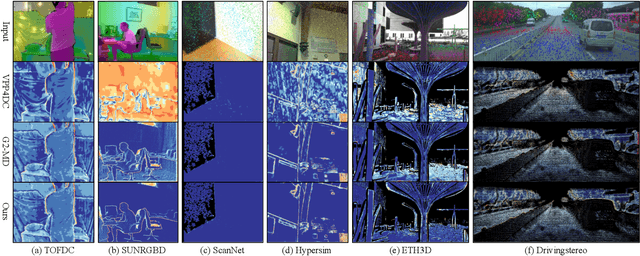

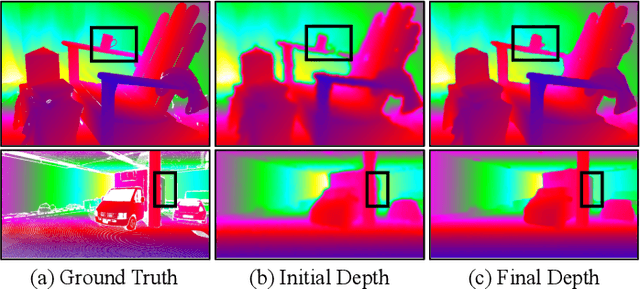

Abstract:Depth completion is a pivotal challenge in computer vision, aiming at reconstructing the dense depth map from a sparse one, typically with a paired RGB image. Existing learning based models rely on carefully prepared but limited data, leading to significant performance degradation in out-of-distribution (OOD) scenarios. Recent foundation models have demonstrated exceptional robustness in monocular depth estimation through large-scale training, and using such models to enhance the robustness of depth completion models is a promising solution. In this work, we propose a novel depth completion framework that leverages depth foundation models to attain remarkable robustness without large-scale training. Specifically, we leverage a depth foundation model to extract environmental cues, including structural and semantic context, from RGB images to guide the propagation of sparse depth information into missing regions. We further design a dual-space propagation approach, without any learnable parameters, to effectively propagates sparse depth in both 3D and 2D spaces to maintain geometric structure and local consistency. To refine the intricate structure, we introduce a learnable correction module to progressively adjust the depth prediction towards the real depth. We train our model on the NYUv2 and KITTI datasets as in-distribution datasets and extensively evaluate the framework on 16 other datasets. Our framework performs remarkably well in the OOD scenarios and outperforms existing state-of-the-art depth completion methods. Our models are released in https://github.com/shenglunch/PSD.
SP-VLA: A Joint Model Scheduling and Token Pruning Approach for VLA Model Acceleration
Jun 15, 2025Abstract:Vision-Language-Action (VLA) models have attracted increasing attention for their strong control capabilities. However, their high computational cost and low execution frequency hinder their suitability for real-time tasks such as robotic manipulation and autonomous navigation. Existing VLA acceleration methods primarily focus on structural optimization, overlooking the fact that these models operate in sequential decision-making environments. As a result, temporal redundancy in sequential action generation and spatial redundancy in visual input remain unaddressed. To this end, we propose SP-VLA, a unified framework that accelerates VLA models by jointly scheduling models and pruning tokens. Specifically, we design an action-aware model scheduling mechanism that reduces temporal redundancy by dynamically switching between VLA model and a lightweight generator. Inspired by the human motion pattern of focusing on key decision points while relying on intuition for other actions, we categorize VLA actions into deliberative and intuitive, assigning the former to the VLA model and the latter to the lightweight generator, enabling frequency-adaptive execution through collaborative model scheduling. To address spatial redundancy, we further develop a spatio-semantic dual-aware token pruning method. Tokens are classified into spatial and semantic types and pruned based on their dual-aware importance to accelerate VLA inference. These two mechanisms work jointly to guide the VLA in focusing on critical actions and salient visual information, achieving effective acceleration while maintaining high accuracy. Experimental results demonstrate that our method achieves up to 1.5$\times$ acceleration with less than 3% drop in accuracy, outperforming existing approaches in multiple tasks.
CPRet: A Dataset, Benchmark, and Model for Retrieval in Competitive Programming
May 19, 2025Abstract:Competitive programming benchmarks are widely used in scenarios such as programming contests and large language model assessments. However, the growing presence of duplicate or highly similar problems raises concerns not only about competition fairness, but also about the validity of competitive programming as a benchmark for model evaluation. In this paper, we propose a new problem -- similar question retrieval -- to address this issue. Due to the lack of both data and models, solving this problem is challenging. To this end, we introduce CPRet, a retrieval-oriented benchmark suite for competitive programming, covering four retrieval tasks: two code-centric (i.e., Text-to-Code and Code-to-Code) and two newly proposed problem-centric tasks (i.e., Problem-to-Duplicate and Simplified-to-Full), built from a combination of automatically crawled problem-solution data and manually curated annotations. Our contribution includes both high-quality training data and temporally separated test sets for reliable evaluation. In addition, we develop two task-specialized retrievers based on this dataset: CPRetriever-Code, trained with a novel Group-InfoNCE loss for problem-code alignment, and CPRetriever-Prob, fine-tuned for identifying problem-level similarity. Both models achieve strong results and are open-sourced for local use. Finally, we analyze LiveCodeBench and find that high-similarity problems inflate model pass rates and reduce differentiation, underscoring the need for similarity-aware evaluation in future benchmarks. Code and data are available at: https://github.com/coldchair/CPRet
Point2Primitive: CAD Reconstruction from Point Cloud by Direct Primitive Prediction
May 04, 2025


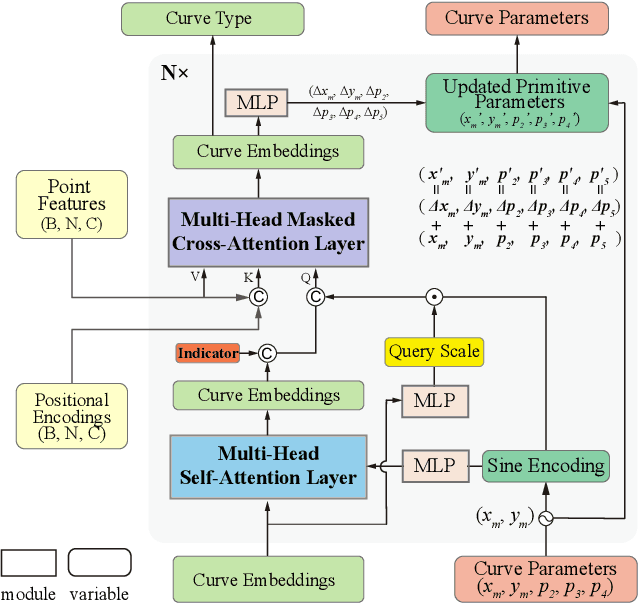
Abstract:Recovering CAD models from point clouds, especially the sketch-extrusion process, can be seen as the process of rebuilding the topology and extrusion primitives. Previous methods utilize implicit fields for sketch representation, leading to shape reconstruction of curved edges. In this paper, we proposed a CAD reconstruction network that produces editable CAD models from input point clouds (Point2Primitive) by directly predicting every element of the extrusion primitives. Point2Primitive can directly detect and predict sketch curves (type and parameter) from point clouds based on an improved transformer. The sketch curve parameters are formulated as position queries and optimized in an autoregressive way, leading to high parameter accuracy. The topology is rebuilt by extrusion segmentation, and each extrusion parameter (sketch and extrusion operation) is recovered by combining the predicted curves and the computed extrusion operation. Extensive experiments demonstrate that our method is superior in primitive prediction accuracy and CAD reconstruction. The reconstructed shapes are of high geometrical fidelity.
CMT: A Cascade MAR with Topology Predictor for Multimodal Conditional CAD Generation
Apr 29, 2025Abstract:While accurate and user-friendly Computer-Aided Design (CAD) is crucial for industrial design and manufacturing, existing methods still struggle to achieve this due to their over-simplified representations or architectures incapable of supporting multimodal design requirements. In this paper, we attempt to tackle this problem from both methods and datasets aspects. First, we propose a cascade MAR with topology predictor (CMT), the first multimodal framework for CAD generation based on Boundary Representation (B-Rep). Specifically, the cascade MAR can effectively capture the ``edge-counters-surface'' priors that are essential in B-Reps, while the topology predictor directly estimates topology in B-Reps from the compact tokens in MAR. Second, to facilitate large-scale training, we develop a large-scale multimodal CAD dataset, mmABC, which includes over 1.3 million B-Rep models with multimodal annotations, including point clouds, text descriptions, and multi-view images. Extensive experiments show the superior of CMT in both conditional and unconditional CAD generation tasks. For example, we improve Coverage and Valid ratio by +10.68% and +10.3%, respectively, compared to state-of-the-art methods on ABC in unconditional generation. CMT also improves +4.01 Chamfer on image conditioned CAD generation on mmABC. The dataset, code and pretrained network shall be released.
UniSTD: Towards Unified Spatio-Temporal Learning across Diverse Disciplines
Mar 26, 2025Abstract:Traditional spatiotemporal models generally rely on task-specific architectures, which limit their generalizability and scalability across diverse tasks due to domain-specific design requirements. In this paper, we introduce \textbf{UniSTD}, a unified Transformer-based framework for spatiotemporal modeling, which is inspired by advances in recent foundation models with the two-stage pretraining-then-adaption paradigm. Specifically, our work demonstrates that task-agnostic pretraining on 2D vision and vision-text datasets can build a generalizable model foundation for spatiotemporal learning, followed by specialized joint training on spatiotemporal datasets to enhance task-specific adaptability. To improve the learning capabilities across domains, our framework employs a rank-adaptive mixture-of-expert adaptation by using fractional interpolation to relax the discrete variables so that can be optimized in the continuous space. Additionally, we introduce a temporal module to incorporate temporal dynamics explicitly. We evaluate our approach on a large-scale dataset covering 10 tasks across 4 disciplines, demonstrating that a unified spatiotemporal model can achieve scalable, cross-task learning and support up to 10 tasks simultaneously within one model while reducing training costs in multi-domain applications. Code will be available at https://github.com/1hunters/UniSTD.
3DAxisPrompt: Promoting the 3D Grounding and Reasoning in GPT-4o
Mar 17, 2025Abstract:Multimodal Large Language Models (MLLMs) exhibit impressive capabilities across a variety of tasks, especially when equipped with carefully designed visual prompts. However, existing studies primarily focus on logical reasoning and visual understanding, while the capability of MLLMs to operate effectively in 3D vision remains an ongoing area of exploration. In this paper, we introduce a novel visual prompting method, called 3DAxisPrompt, to elicit the 3D understanding capabilities of MLLMs in real-world scenes. More specifically, our method leverages the 3D coordinate axis and masks generated from the Segment Anything Model (SAM) to provide explicit geometric priors to MLLMs and then extend their impressive 2D grounding and reasoning ability to real-world 3D scenarios. Besides, we first provide a thorough investigation of the potential visual prompting formats and conclude our findings to reveal the potential and limits of 3D understanding capabilities in GPT-4o, as a representative of MLLMs. Finally, we build evaluation environments with four datasets, i.e., ScanRefer, ScanNet, FMB, and nuScene datasets, covering various 3D tasks. Based on this, we conduct extensive quantitative and qualitative experiments, which demonstrate the effectiveness of the proposed method. Overall, our study reveals that MLLMs, with the help of 3DAxisPrompt, can effectively perceive an object's 3D position in real-world scenarios. Nevertheless, a single prompt engineering approach does not consistently achieve the best outcomes for all 3D tasks. This study highlights the feasibility of leveraging MLLMs for 3D vision grounding/reasoning with prompt engineering techniques.
Revisiting Convolution Architecture in the Realm of DNA Foundation Models
Feb 25, 2025Abstract:In recent years, a variety of methods based on Transformer and state space model (SSM) architectures have been proposed, advancing foundational DNA language models. However, there is a lack of comparison between these recent approaches and the classical architecture convolutional networks (CNNs) on foundation model benchmarks. This raises the question: are CNNs truly being surpassed by these recent approaches based on transformer and SSM architectures? In this paper, we develop a simple but well-designed CNN-based method termed ConvNova. ConvNova identifies and proposes three effective designs: 1) dilated convolutions, 2) gated convolutions, and 3) a dual-branch framework for gating mechanisms. Through extensive empirical experiments, we demonstrate that ConvNova significantly outperforms recent methods on more than half of the tasks across several foundation model benchmarks. For example, in histone-related tasks, ConvNova exceeds the second-best method by an average of 5.8%, while generally utilizing fewer parameters and enabling faster computation. In addition, the experiments observed findings that may be related to biological characteristics. This indicates that CNNs are still a strong competitor compared to Transformers and SSMs. We anticipate that this work will spark renewed interest in CNN-based methods for DNA foundation models.
Model Decides How to Tokenize: Adaptive DNA Sequence Tokenization with MxDNA
Dec 18, 2024Abstract:Foundation models have made significant strides in understanding the genomic language of DNA sequences. However, previous models typically adopt the tokenization methods designed for natural language, which are unsuitable for DNA sequences due to their unique characteristics. In addition, the optimal approach to tokenize DNA remains largely under-explored, and may not be intuitively understood by humans even if discovered. To address these challenges, we introduce MxDNA, a novel framework where the model autonomously learns an effective DNA tokenization strategy through gradient decent. MxDNA employs a sparse Mixture of Convolution Experts coupled with a deformable convolution to model the tokenization process, with the discontinuous, overlapping, and ambiguous nature of meaningful genomic segments explicitly considered. On Nucleotide Transformer Benchmarks and Genomic Benchmarks, MxDNA demonstrates superior performance to existing methods with less pretraining data and time, highlighting its effectiveness. Finally, we show that MxDNA learns unique tokenization strategy distinct to those of previous methods and captures genomic functionalities at a token level during self-supervised pretraining. Our MxDNA aims to provide a new perspective on DNA tokenization, potentially offering broad applications in various domains and yielding profound insights.
COMET: Benchmark for Comprehensive Biological Multi-omics Evaluation Tasks and Language Models
Dec 13, 2024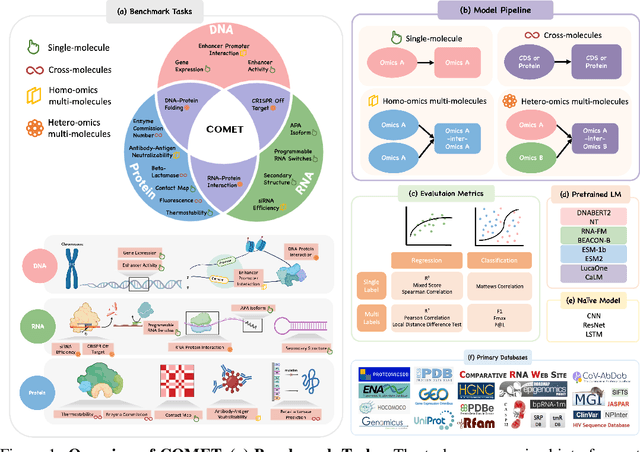
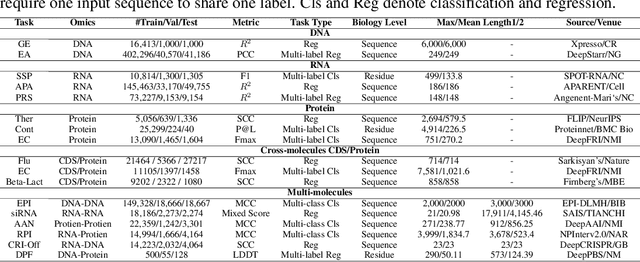

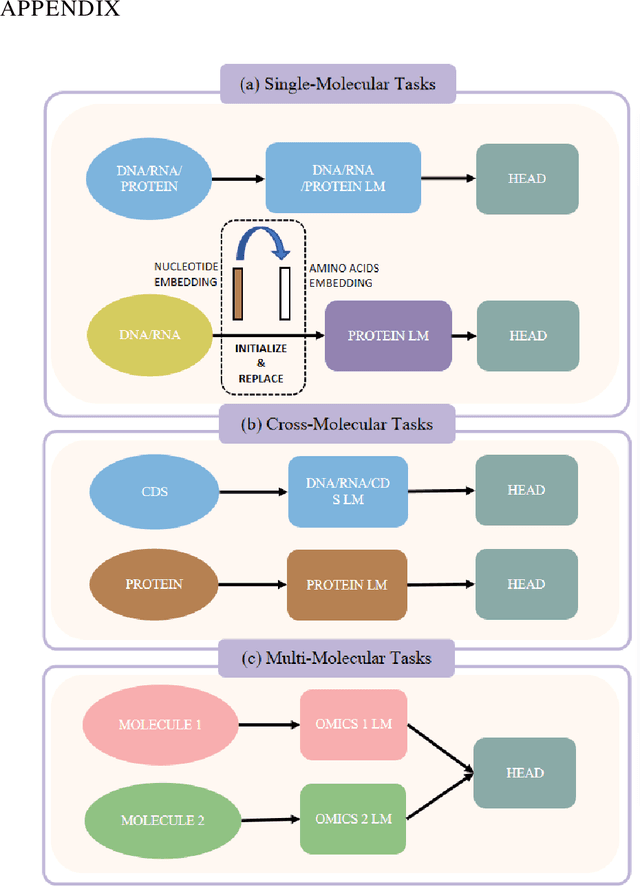
Abstract:As key elements within the central dogma, DNA, RNA, and proteins play crucial roles in maintaining life by guaranteeing accurate genetic expression and implementation. Although research on these molecules has profoundly impacted fields like medicine, agriculture, and industry, the diversity of machine learning approaches-from traditional statistical methods to deep learning models and large language models-poses challenges for researchers in choosing the most suitable models for specific tasks, especially for cross-omics and multi-omics tasks due to the lack of comprehensive benchmarks. To address this, we introduce the first comprehensive multi-omics benchmark COMET (Benchmark for Biological COmprehensive Multi-omics Evaluation Tasks and Language Models), designed to evaluate models across single-omics, cross-omics, and multi-omics tasks. First, we curate and develop a diverse collection of downstream tasks and datasets covering key structural and functional aspects in DNA, RNA, and proteins, including tasks that span multiple omics levels. Then, we evaluate existing foundational language models for DNA, RNA, and proteins, as well as the newly proposed multi-omics method, offering valuable insights into their performance in integrating and analyzing data from different biological modalities. This benchmark aims to define critical issues in multi-omics research and guide future directions, ultimately promoting advancements in understanding biological processes through integrated and different omics data analysis.
 Add to Chrome
Add to Chrome Add to Firefox
Add to Firefox Add to Edge
Add to Edge